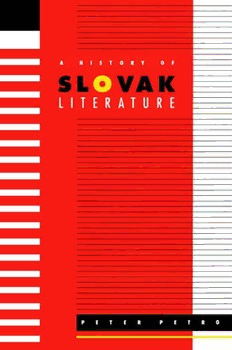
A history of Slovak literature PDF
Preview A history of Slovak literature
A History of Slovak Literature In spite of its richness and long history, Slovak literature is one of the least-known Slavic literatures in the English-speaking world. Few trans- lations of Slovak works exist and until now there has been no systematic English-language history of this field. A History of Slovak Literature pro- vides an excellent introduction to this important but overlooked body of writing. Starting with the Great Moravian period, Peter Petro surveys one thousand years of Slovak literature. He examines the medieval, renais- sance, baroque, classical, romantic, realist, and modern periods and highlights the contributions of such writers as Nedozersky, Tranovsky, Papanek, Safarik, Kollar, Zaborsky, Vajansky, Hviezdoslav, Kukucm, Hronsky, Tatarka, and Rufus. Like Czech, Polish, and Ukrainian writing, Slovak literature tran- scended the merely literary to become an influential political and cul- tural tool: Slovak writers and poets played an important role in promoting and protecting the culture and language of their people against invading cultures. A History of Slovak Literature will be a welcome addition to the field of Slavic studies. PETER PETRO is associate professor of Russian, East European, and comparative literature, University of British Columbia. This page intentionally left blank A History of Slovak Literature PETER PETRO McGill-Queens University Press Montreal & Kingston • London • Buffalo McGill-Queen's University Press 1995 ISBN 0-7735-1311-6 (cloth) ISBN 0-7735-1402-3 (paper) Legal deposit fourth quarter 1995 Bibliotheque nationale du Quebec Printed in Canada on acid-free paper Paperback edition 1996 Published simultaneously in the European Union by Liverpool University Press. This book has been published with the help of a grant from the Canadian Federation for the Humanities, using funds provided by the Social Sciences and Humanities Research Council of Canada. McGill-Queen's University Press is grateful to the Canada Council for support of its publishing program. Canadian Cataloguing in Publication Data Petro, Peter A history of Slovak literature Includes bibliographical references and index. ISBN 0-7735-1311-6 i. Slavic literature - History and criticism. I. Title. PG5401.P48 1995 89i.8'7og 095-900408-4 This book was typeset by Typo Litho Composition Inc. in 10/12 Baskerville. Contents Acknowledgments vii Preface ix Introduction 3 1 Medieval Literature (800-1467) 8 2 The Renaissance (1467-1636) 14 3 Baroque (1636-1780) 25 4 Classicism (1780-1828) 42 5 Romanticism (1828-71) 64 6 Realism (1871-1918) 93 7 Modern Literature (1918-90) 130 Conclusion 154 Bibliography 157 Index 161 This page intentionally left blank Acknowledgments I would like to thank Kevin Michael Grace for his assistance with the fi- nal draft of my manuscript: his editorial skill, criticism, and erudition were as appreciated as his friendship. I am also very thankful for the support my project has received from the Cultural Foundation of the Slovak World Congress and its direc- tors. My inquiries to Matica slovenska, in Bratislava, were promptly an- swered, through I do regret that I did not have the opportunity to do research in its library. I am very grateful for the practical help of Father Felix Litva, sj, pro- fessor at the Gregorian University in Rome, without whose personal in- tercession the bulk of my manuscript would not have been written. Father Sebastian Kosiit's indomitable optimism and helpfulness and my conversations with Stano Dusik in Florence were both extremely helpful. Finally, I would like to thank Dr. Imrich Kruzliak, who sug- gested this project to me and believed that I could execute it. Much of the last chapter was originally presented as a lecture to a conference on Czechoslovakia 1918-88, on October 28, 1988, in To- ronto. Josef Skvorecky's kind and encouraging comments were ex- tremely helpful, as were the suggestions of Professor H. Gordon Skill- ing. Much of what I have to say about Hronsky, Sikula, the surrealists, and the 19605 appeared in the periodical Slovakia (1982-83). I re- ceived encouragement in the writing of these articles from Professor Bogdan Czaykowski, of the University of British Columbia, who sup- ported my interest in Slovak literature. viii Acknowledgments All translations are mine. For texts quoted from well-known classics, I assume standard editions and do not provide citations. Occasionally, I provide a source quotation, as an example or when the text has extra- literary implications. Preface Those who read the story of Slovak literature may be compared to the old rafters on the river Vah. They made their rafts upstream, al- most at the source of the river, high in the mountains, where the riv- ers are born. When they first launched their craft, they sped down the river. With each part of their journey, the river became wider, as the heretofore constricting valleys gave way to a wide, open plain. There was more to see, and what there was appeared more complex and more difficult to make out from the middle of the river. Finally, they arrived at the mouth of the Vah, where it joins the Danube. The Vah was a mature river here, its waters not that different from those of the bigger, cosmopolitan Danube. And so it is with Slovak litera- ture: in its maturity, it is a distinguished member of the European family of literatures. Slovak literature itself can be compared to Cinderella: the beauty, ability, and potential for fame are there, but it is unknown, or at any rate less well known than it deserves to be - to the English-speaking word, at any rate. Few translations exist to remedy this lack of knowl- edge. Nevertheless, the world is beginning to take notice of Slovak lit- erature, as evidenced by the international conference, organized by the University of London's School of Slavonic and Eastern European Studies, entitled "Slovak Prose After 1954" (1987). The first to deal with this literature and a fitting testimonial to its growing importance, the conference dealt with more than a dozen very talented Slovak nov- elists. This is a step in the right direction. The next step should be sys- tematic translation of the best Slovak literature, past and present.
